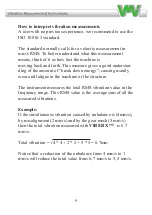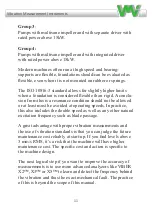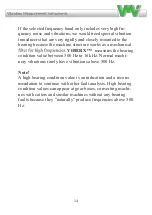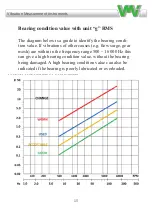
13
Vibration Measurement Instruments
•
7 – 18 mm/s
Large vibrations. Bearings running hot. Bearing wear-out cause
frequent replacements. Seals wear out, leakage of all kinds evident.
Cracks in welding and concrete foundations. Screws and bolts are
loosening. High noise level. Plan action soonest. Do your best to
reveal the reason. You are wearing down investments quickly.
•
18 – mm/s
Very large vibrations and high noise levels. This is detrimental to
the safe operation of the machine. Stop operation if technically
or economically possible considering the plant stop cost. Few
machines can withstand this level without damage. Reduce any
further running time to an absolute minimum.
Manual Viber X1_121002.indd 13
10/3/12 9:26 AM
Vibration Measurement Instruments
Recommended vibration levels in mm/s and
common fi ndings
The following is in part an extraction of the old standard ISO 2372
class 4, large machines on fl exible foundations, with some com-
mon fi ndings added.
This simplifi ed list can be used, as a fi rst indication, when
approaching a machine newly commissioned or after some
time in operation.
Take as a rule to investigate the reason for any machine that vi-
brates above 3 mm/s RMS.
•
0 – 3 mm/s
Small vibrations - None or very small bearing wear. Rather low
noise level.
•
3 – 7 mm/s
Noticeable vibration levels often concentrated to some specifi c
part as well as direction of the machine. Visible bearing wear.
Seal problems occur in pumps and increased noise level. Keep
the machine under observation and measure at smaller time inter-
vals than before to detect a deterioration trend if any.
Compare vibrations to other operating variables.
Manual Viber X1_121002.indd 12
10/3/12 9:26 AM
•
18 – mm/s
Very large vibrations and high noise levels. This is detrimental
to the safe operation of the machine. Stop operation if techni-
cally or economically possible. Few machines can withstand
this level without damage. Reduce any further running time to
an absolute minimum.
Press the bearing symbol. The instrument measures the bearing
condition value. Bearing condition value is the RMS value of
all high frequency vibrations in the range of 500 Hz to 16 000
Hz. Bearing condition are measured in the unit g.
Bearing condition value
We use acceleration because high frequencies give a larger sig-
nal compared to velocity, if measured in acceleration. When
the balls or rollers rotate inside the bearing, a wide-band noise
and vibration occurs. This noise and vibration increase if the
bearing is poorly lubricated, overloaded due to misalignment
or has a damaged surface.
If the selected frequency band includes low frequencies, the be-
aring condition value would also include vibrations from unba-
lance, misalignment, etc. and not only from bearing vibrations.
Vibration Measurement Instruments
Press the bearing symbol and the instrument measures the bearing
condition value.
Bearing condition value is RMS value of all high frequency vibra-
tions in the range of 500 Hz to maximum frequency.
This average has the unit g (= m/s²)
Bearing condition value
The bearing condition value in VIBER X1™ is an average value,
RMS value, of all high frequency vibrations between 500 Hz and
maximum frequency.
This value is an average with the unit “g” because high frequen-
cies give a larger signal compared with velocity, if it is measured
in acceleration.
When the balls or rollers rotate inside the bearing a wide-band
noise and vibration arises. This noise and vibration are increased
if the bearing is poorly lubricated, overloaded due to misalignment
or has a damaged surface.
If the selected frequency band includes low frequencies, the
bearing condition value would also include vibrations from
unbalance, misalignment, etc. and not only from bearing vibrations
and would therefore be diffi cult to interpret.
If the selected frequency band only includes very high frequency
noise and vibrations we would need special vibration transducers
that are very rigidly and closely mounted to the bearing because
Bearing condition
Manual Viber X1_121002.indd 14
10/3/12 9:26 AM
Bearing condition symbol






































